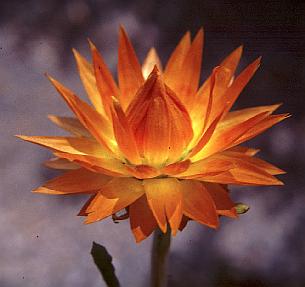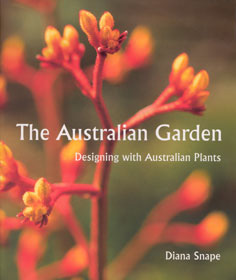|
[Front Page] [Features] [Departments] [Society Home] [Subscribe]

A Good Read
.....what's worth a look?
Reviews in this issue cover Everlasting Daisies of Australia by the Australian Daisy Study Group, The Australian Garden: Designing with Australian Plants by Diana Snape and Families of Flowering Plants of Australia CD-ROM. |
 |

 
Everlasting Daisies of Australia: Identification, Propagation, Cultivation
Australian Daisy Study Group
Published by C.H.Jerram and Associates
Soft cover, 196 pages, colour photos
$A49.95
Reviewed by Elspeth Jacobs
If you have not been involved with growing and appreciating everlasting daisies before reading this book, you certainly will be after reading it. Five years of dedicated research into all aspects of this group of plants, has resulted in a wonderful "must-have" publication. In fact, I can think of no other plant book (except perhaps The Grevillea Book by Olde and Marriot) which so thoroughly demonstrates the authors' great personal knowledge of and experience with the plants they write of, both in their natural habitat, and as horticultural subjects. It is a true marriage of accurate botanical knowledge and practical "how-to" information.
 
The detailed early chapters cover every aspect of the botany, propagation, horticulture. floral art. floriculture, reproduction, and hybridisation of these beautiful plants. It is important not to rush to the second part of the book - the detailed description of each species, but spend time on the wealth of information in these early chapters.
The bulk of the book consists of the detailed descriptions of the over 100 species in the 12 genera of everlasting daisies thai are covered. These descriptions cover size. colour, common name, explanation of the species name. flowering period, propagation, cultivation and uses, distribution and habitat, synonyms, and similar species.
One very pleasing aspect is the inclusion of the species name in cultivars (not usual practice), so that Rhodanthe 'Paper Baby' is not used, but Rhodanthe anthemoides 'Paper Baby'. This way this origin of the cultivar can be immediately appreciated.
The inclusion of synonyms is also greatly appreciated, particularly with the inevitable name changes that have taken place.
The colour photographs accompanying each species are superb, and detailed enough to assist with identification. Likewise the botanical drawings are excellent, and the full glossary assists with any uncertainty with terminology.
The only lack for me was a key to show the differences between the 12 genera* (see note below). Maybe this would have required far too detailed botanical knowledge for the average reader, and perhaps access to a microscope.
This is a gem of a book that will become the constant companion of both amateur and professional lovers of Australian plants.
Congratulations to the ADSG for such a comprehensive, user-friendly, and wonderful addition to our ever-growing knowledge of Australian plants. Maybe some other Study Groups will be challenged and encouraged to undertake such a venture in their field of interest.
* Note from Judy Barker (Leader of the Australian Daisy Study Group): At all times we were careful not to represent ourselves as professional botanists or taxonomists, but merely as gardeners with enthusiasm. The salient features of each genus are set out in the introduction to each genus. That, together with the prints of plants and seeds, should help distinguish genera. Only existing keys prepared by botanists following recent revisions were included in the book. Botanists abhor laymen producing keys! Comprehensive keys in State flora include ALL genera in Asteraceae and cannot be adapted to the genera chosen for this study. In any case, they are State-based not Australia-based.
Reprinted from Growing Australian, newsletter of the Australian Plants Society (Victoria), September 2002.

 
The Australian Garden: Designing with Australian Plants
Diana Snape
Published by Blooming Books, Melbourne, 2002.
232 pages, over 100 colour plates, hardback
$A55.00.
Reviewed by Tony Cavanagh
 
This is a beautiful book and both the author and her associates, and the publisher, should be proud of it. The quality of the illustrations and their incorporation within the text make the book a delight to read. In her introduction, the author Diana Snape, states that she is "passionate" about her garden, a garden that she and her husband Brian created over a thirty year period, and which is still evolving. Drawing on inspiration from the Australian landscape, and the versatility of Australian plants to be incorporated into the design of gardens for all purposes and locations, she emphasises the need to work in partnership with nature, not in conflict, and to recognise and accept what the Australian environment has to offer - "our garden celebrates nature's charms and strengths". This same belief and enthusiasm underlies the purpose and presentation of this book - to show how Australian plants can be used in all gardening situations and to challenge the reader to try to incorporate some of the ideas into their own gardens.
Diana Snape is leader of the Garden Design Study Group within ASGAP. The group has researched the use of Australian plants in garden design over the last ten years and this book can be regarded as a "distillation" of the knowledge and input from several hundred members. In her first book, Australian Native Gardens: Putting Visions into Practice (Melbourne, Lothian, 1992), the author featured 30 outstanding native gardens, describing and photographing them and interviewing their owners for their "personal gardening philosophies". The present book is a natural follow-on but this time emphasising the overall means of creating one's own outstanding Australian garden. It is divided into five major sections. The first outlines design principles and planning the garden; the next discusses some twenty styles of garden including lists of plants that suit each; the third examines the role of the plants themselves in garden design, from trees to groundcover and those that perform the four design roles of "framework", "feature", "ornamental" and "infill"; the fourth brings much of the above knowledge together in looking at some of the practical aspects of the garden - the importance of the "hard" landscape, paths, fences etc., the beauty and tranquility of water, use of colour, the "sensuous" garden and bringing wildlife to the garden; and finally, an all-too-brief section on problems and challenges and the need to manage the garden. Each section has numerous suggested and recommended plants but the real joy are the magnificent photographs, some in large-format over two pages, admirably chosen to emphasise the theme of the section. The book concludes with an appendix of indigenous plants for use in garden design in the various capital cities, an excellent thematic bibliography and information on and addresses of the various SGAP/APS groups in Australia.
I found this a beautifully laid-out book with very pleasing use of coloured pages and boxes to enhance the text. The wealth of information could almost be overwhelming were it not for the numerous illustrations (at least one per page spread) and their helpful text. It will take time to digest but the author writes in an easy and informal style and many of us will concentrate on the sections that interest us. I was pleased to see the range of garden styles discussed - "walkabout gardens" (a garden to wander in), "naturalistic gardens" (a modified version of the "bush garden"), "tapestry gardens" (using foliage to create patterns and contrasts) and tlie "blended garden" (a garden that contains plants not indigenous to the area, but generally applied to a "mixed" native/exotic garden). My only criticisms are the brevity of the discussion on theme gardens and collectors gardens (less than a quarter of a page on each) and on garden maintenance and garden rejuvenation. I am sure that many APS members would like to know more about how to indulge their passion for collecting native plants and still make a designed garden; this could perhaps be considered in a future edition. I suppose my pet "gripe" about most of the pictures we see of Australian gardens is that most of the gardens are young, just a few years old (or the age is not given), and rarely do we see what the same garden looks like in 10 or 15 years. Many native plants become straggly with age and shading and it really is a challenge to maintain a designed garden over many years. I would like to have seen this issue discussed in greater depth and also the allied problem of rejuvenating an old garden.
These minor issues aside, this is a delightful and useful book, well worth its cost for the pictures alone, and would make a great Christmas gift. The information is invaluable for anyone wishing to know more about how to use Australian plants, and for growing them with more flair than simply putting them in the ground.
Highly recommended.
Reprinted from Growing Australian, newsletter of the Australian Plants Society (Victoria), December 2002.

 
Families of Flowering Plants of Australia: An Interactive Identification Guide
K.R.Thiele & L.G.Adams (eds)
Windows CD-ROM
Published by CSIRO Publishing, PO Box 1139 (150 Oxford Street), Collingwood, Victoria 3066, Australia. Email: sales@publish.csiro.au.
Revised Edition Feb 2002, CD-ROM, ISBN: 0643067213
$A69.95
Reviewed by Kevin Sparrow
Trying to identify a plant from the many thousands that grow in Australia can be a difficult task. If the flower is of a recognisable shape such as a pea flower, then the Fabaceae plant family is a good place to look. However, if the plant family is not obvious then where do you start?
Similar to the interactive CD ROM "Wattle - Acacias of Australia" (reviewed in the December 2001 issue of Australian Plants online) is another CD ROM also published by the Australian Biological Resources Study called "Families of Flowering Plants of Australia". This CD ROM is designed to assist will] the identification of plant - a good place to begin the search for that mystery species. While there is in excess of 25000 species of plants in Australia in 2700 genera, they are all grouped into one of 240 families. Once the family is identified it is much easier to find out the species either by using a key or scrolling through the appropriate plant book.

As with the Acacia CD, the program works by eliminating families not selected by the characters chosen. Simply selecting that the species is from a tree removes all families where species do not occur as trees. Similarly choosing characters such as growing region, vegetation community, whether monocotyledon or dicotyledon and leaf and inflorescence type eliminates families not of that type. As you select states from more and more characters, the list of taxa remaining will get shorter and shorter until. hopefully, only one remains. Then you have identified the family to which your tree belongs. Once you get the list down to a few families, simply by clicking on any of the remaining ones, you can bring up notes and a list of images from which you can view selected plant photos to assist in the final identification.
Unless you are familiar with botanical terms you are bound to find characters or character states that you do not understand. Families of Flowering Plants of Australia is provided with illustrations and explanatory notes for most characters to help you in this circumstance. In fact, you can perform an identification using pictures alone.
Unlike a normal key where you must answer each character in turn to continue, with an interactive key such as this you can answer any character at any time. In fact it is a good idea when you start an identification to answer the simple questions first. By scrolling through the list and answering the ones that you are most sure of, you can rind that the name of your family is determined before you need to get to the harder questions. The more complete your specimen is the more likely that you will be able to identify it quickly and easily. Many families can be identified using a combination of leaf and flower (or leaf and fruit) characters, but you are often able to narrow the number of families down using leaf characters alone.
Even though I am not too familiar with botanical terms, I found the program relatively easy to use to at least narrow down the list to a relative few from which I could search further.
Reprinted from Growing Australian, newsletter of the Australian Plants Society (Victoria), September 2002.

[Front Page] [Features] [Departments] [Society Home] [Subscribe]
Australian Plants online - December 2002
Association of Societies for Growing Australian Plants
|